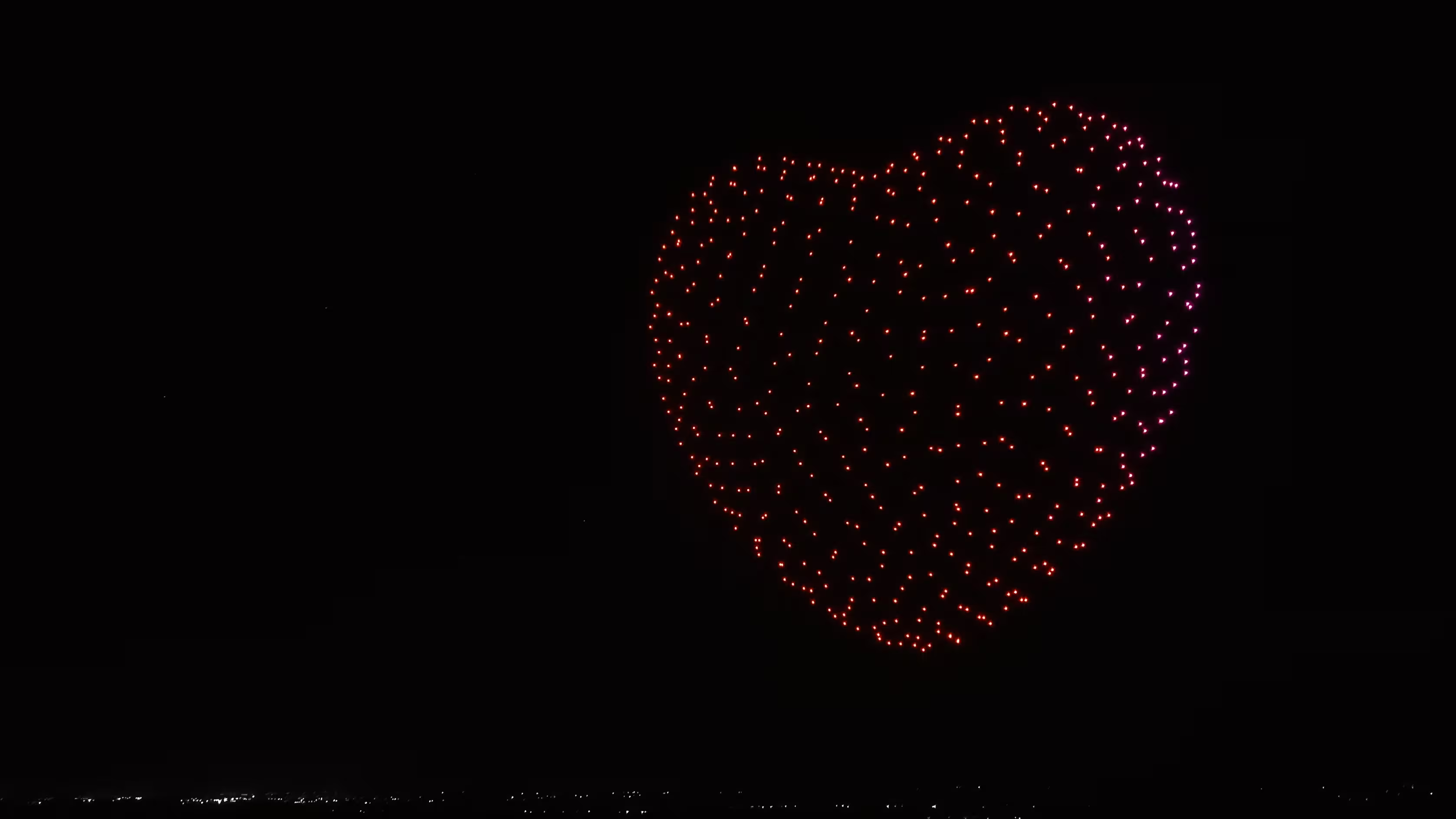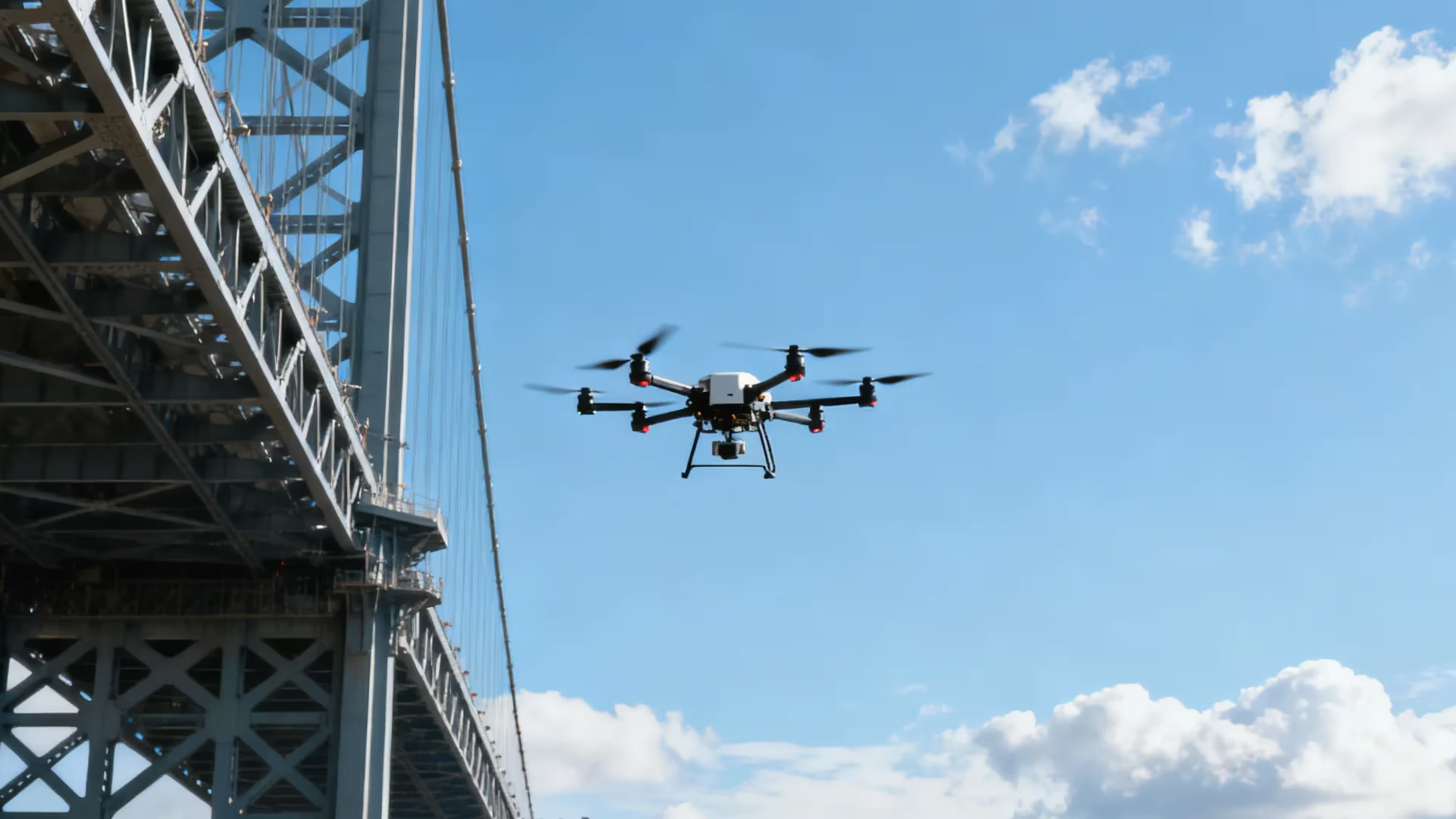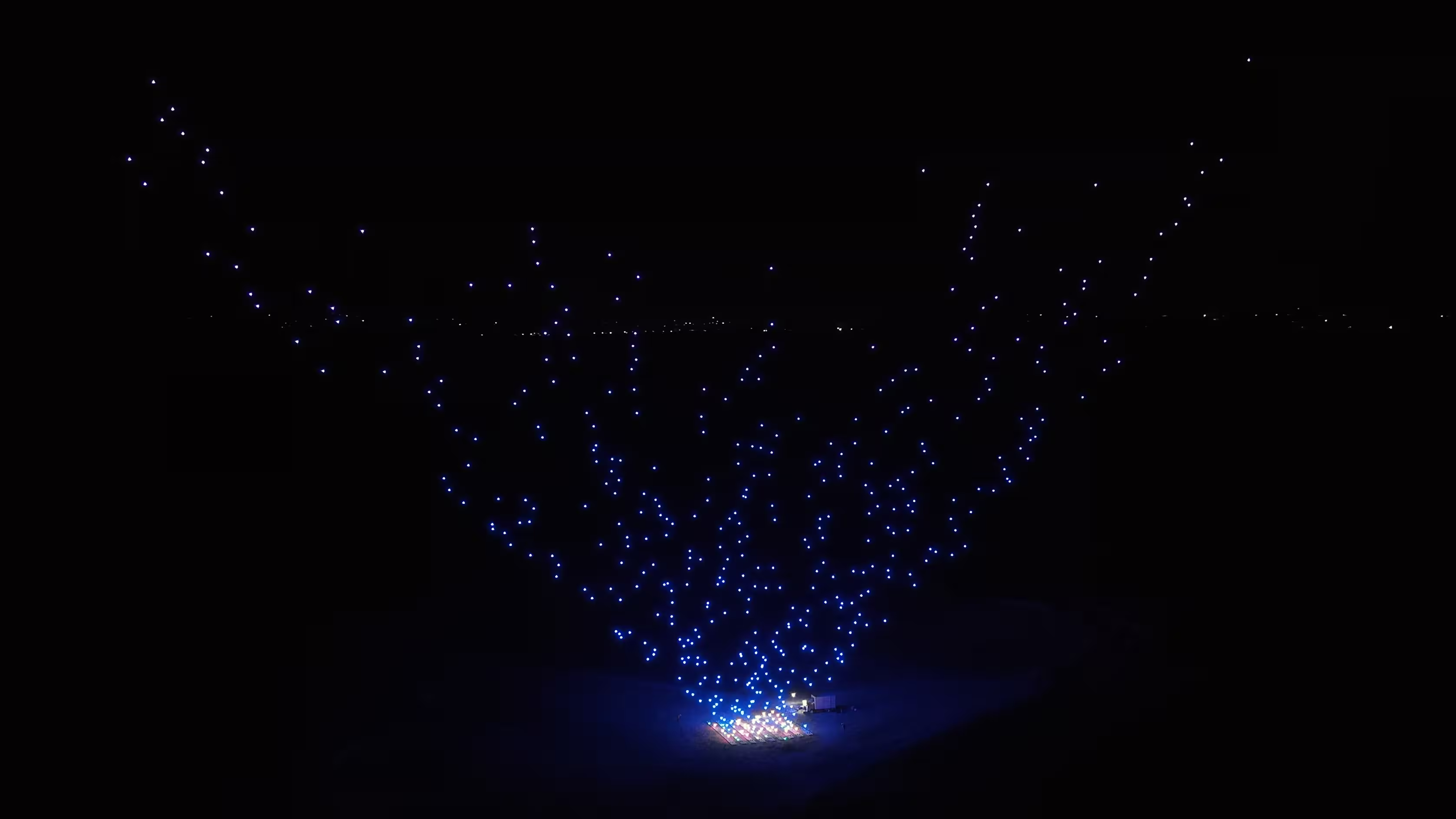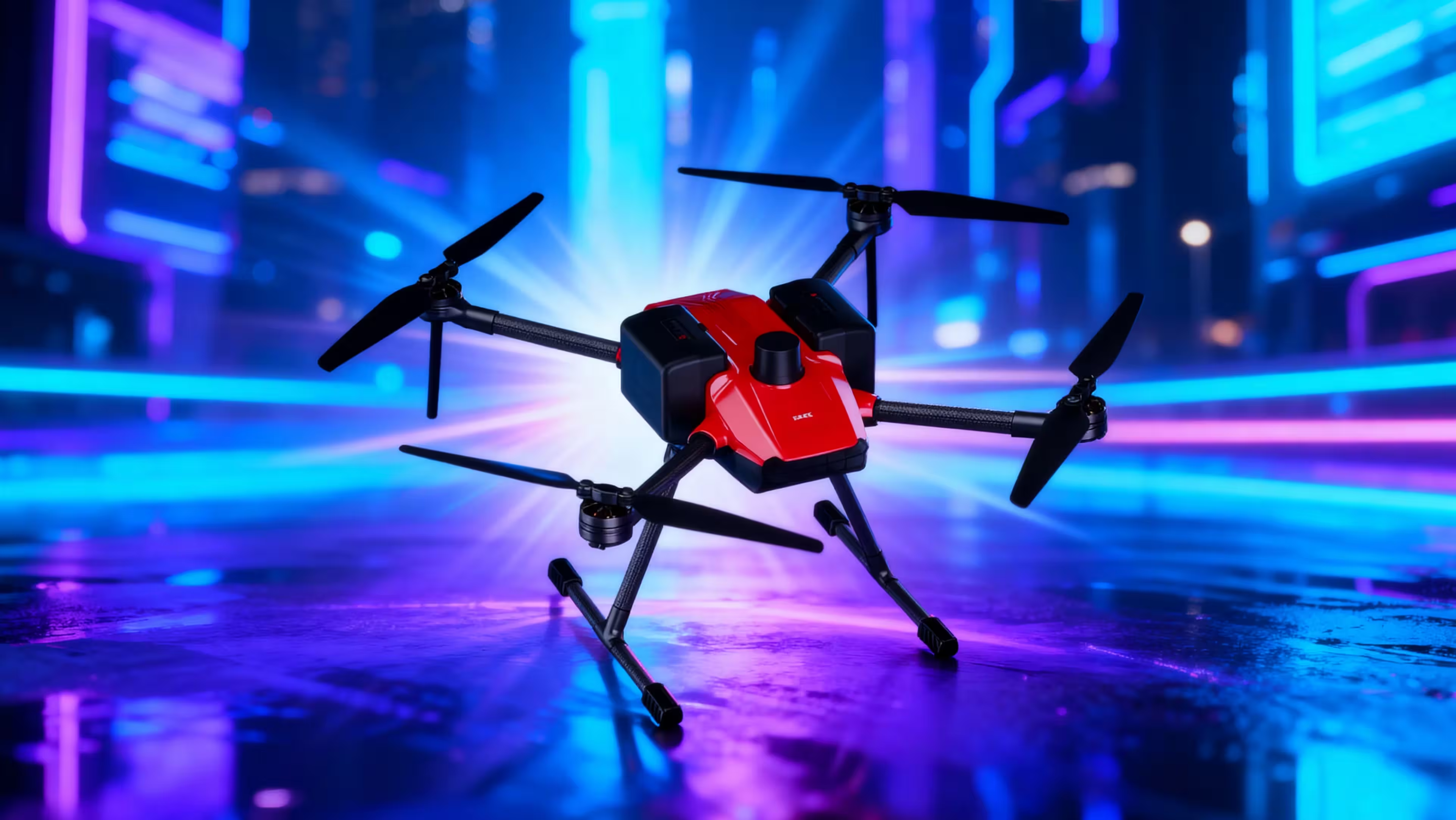They said the sky had grown crowded.
Not with birds—those were nearly gone from the industrial belts—but with signals, demands, encrypted packets of instructions, the endless pulse of infrastructure trying to keep itself alive. Every tower, every pipeline, every perimeter, every convoy, every emergency zone whispered its coordinates into the world, asking for eyes, for reach, for a presence beyond human limitation.
Out on the edges of cities—where the concrete bruises into dust and high-tension lines hum like old ghosts—there were machines built for this new kind of silence. Machines that could slip between the noise and return with clarity.
One of them earned an unusual kind of reputation among field teams, power-grid patrol units, police response groups, and the quiet technicians who kept remote energy assets alive at the edge of civilization. They didn’t call it by its full designation at first. It simply became a familiar shadow, reliable as a heartbeat, efficient as a thought.
Its name was Skylle Ⅱ.
And in a world where uncertainty had become the default operating environment, this machine did something almost quaint:
It restored confidence.

1. A Frame Born of Pressure and Necessity
People who work in unstable places have a certain way of moving—controlled, cautious, every gesture trimmed down to utility. The same kind of philosophy is carved directly into the frame of Skylle Ⅱ.
Its body is formed from aviation-grade carbon fiber, not layered but shaped into existence as a single integrated structure. No excess seams. No unnecessary joints. Nothing waiting to fail when the wind turns dirty with sand or the rain sharpens into needles.
You can tell a lot about a tool by the environments it tolerates.
Some drones complain at the first hint of cold. Others choke on humidity or lose their nerve when the altitude rises past anything resembling human comfort. Skylle Ⅱ doesn’t complain; it adapts. Its rated -20°C to +60°C operating range is not a marketing promise—it’s an admission of where it was designed to work.
The engineers weren’t thinking about sunny test fields or neat demonstration flights. They were thinking of search teams standing in freezing dawn fog, energy crews sweating in mid-summer substations, and operators who didn't have the luxury of canceling a mission because the weather decided to misbehave.
That’s why IP54 protection isn’t an optional note—it’s part of the drone’s personality. Dust storms in dry valleys. Light rain across empty farmlands. Thick coastal moisture creeping into every unprotected circuit. Skylle Ⅱ endures them all, not because it’s armored, but because its structural philosophy is “no weak points.”
There’s a reason field operatives love machines like this:
They do not require belief.
They require deployment.
2. Designed for Those Who Don’t Wait
Time behaves strangely during an emergency.
Minutes warp into impossibly long stretches.
Seconds feel like they’re worth more than money.
When people are waiting—searching for missing workers in mountains, mapping a chemical spill, sweeping a perimeter after an alert—there is no patience for tools that take fifteen minutes to assemble, troubleshoot, calibrate, or baby along.
Skylle Ⅱ’s designers understood this intimately.
Quick-release arms. Quick-release landing gear. Toolless assembly. Modular avionics.
Not buzzwords—survival features.
The arms don’t fold with the soft click of a consumer device. They detach with the decisive certainty of equipment built for crews wearing gloves in wind they can barely stand in. The landing gear doesn’t ask the operator to fiddle with screws. It detaches like a clean thought.
Field teams report assembly times that barely cross the two-minute mark. When packed, the system compresses into efficiently sized storage that respects the realities of vehicle trunks, mobile command vans, or backpack operations where every cubic centimeter counts.
Deployment, in simple terms, becomes irrelevant as a concern.
Skylle Ⅱ is in the air by the time another drone is still being unlatched.
3. The Power to Outlast the Unexpected
In places where communications dead zones stretch wide and long, where power lines run for kilometers without a break, where pipelines carve through landscapes wider than memory, endurance becomes a currency more valuable than speed.
And endurance, for Skylle Ⅱ, is not a statistic—it's a signature.
With its dual 22,000mAh intelligent batteries (and an optional upgrade to 31,000mAh), Skylle Ⅱ bends flight-time expectations. Empty, it can remain aloft for 80 to 100 minutes, depending on the battery configuration. Add a kilogram—still 60 to 95 minutes. Load it with 10kg, its maximum payload capacity—and it remains in the sky for 36 to 50 minutes, depending on the power pack.
These numbers shift field planning strategies.
Most drones can inspect a tower.
Skylle Ⅱ can inspect the tower, the next tower, the valley between them, and the transformer station at the end of the run—all on one flight.
For energy companies, it means fewer takeoffs, fewer battery swaps, fewer opportunities for error. For police and emergency teams, it means a perimeter that doesn’t collapse into blind spots every half hour. For mapping missions, it means covering entire districts in a single sortie.
Endurance is freedom.
And Skylle Ⅱ is engineered to grant it.
4. A Nervous System Made for the Real World
The thing about airborne operations is that nothing works in isolation. Not the drone, not the sensors, not the teams on the ground. Everything must integrate with everything else—and those links must survive when the world throws interference, signal congestion, and electromagnetic noise into the equation.
Skylle Ⅱ wasn’t equipped with avionics so much as a modular computing spine that acts like a nervous system capable of evolving.
The standardized interfaces read like an invitation:
4G/5G modules, dual video transmission, RTK, onboard computer units, ADS-B, secure police network connectivity, custom AI processors.
Each can be inserted, removed, upgraded, or replaced without modifying the drone’s identity. It’s the same philosophy that future-proofed high-end workstation rigs—except here it’s strapped to a carbon-fiber organism moving at 18m/s.
It can switch from surveying farmland to tracking suspects in urban terrain, then shift to delivering supplies in rough landscapes, and transition again to mapping aftershocks across unstable ground—all with different payloads, resolutions, sensors, or compute modules, depending on need.
But the most important part is invisible:
Redundant intelligent battery systems.
A drone designed for hazardous locations can’t rely on single points of failure. When a battery hiccups, a circuit misreads, or interference tries to corrupt power feedback, redundancy is the boundary between mission success and writing a report about why the drone is now a high-tech crater.
Skylle Ⅱ avoids that fate not by luck, but by architecture.
5. Seeing the World With More Than Cameras
A drone is only as useful as what it can carry.
And Skylle Ⅱ carries possibility.
With up to five payloads at once, it becomes less an aircraft and more a multi-sensor platform capable of weaving different threads of data into a single operational picture.
Imagine a mission:
- A mapping camera creating high-resolution orthographic views
- A thermal sensor tracing heat patterns through structures or forests
- A spotlight piercing through fog and dust
- A loudspeaker relaying commands into a chaotic scene
- And an onboard processor analyzing video feeds in real time
All flying simultaneously, harmonized by the drone’s power distribution, avionics spine, and aerodynamic stability.
This isn’t just multi-tasking.
It’s multi-domain influence.
Power companies use it to detect insulator cracks invisible to the naked eye.
Fire agencies use thermal imaging to see through smoke when ground crews cannot.
Police forces monitor moving targets while broadcasting instructions.
Agricultural teams scan crop health and water distribution.
Disaster responders create rapid 3D models of collapsed buildings with accompanying thermal overlays showing where survivors might be.
The payload capacity—10kg—isn’t simply for heavy equipment; it’s for combined equipment, synergistic tools that reshape how missions are planned.
With Skylle Ⅱ, a single flight can collect the kind of layered intelligence that once required convoys of ground vehicles and teams numbering in the dozens.
6. Distance Is No Longer a Barrier
There are places where radio chatter dies completely, where mountains guard valleys like jealous giants and signals collapse under their silent weight. There are urban zones where interference forms a storm of overlapping frequencies, indistinguishable and punishing. There are open plains where distance dulls clarity.
In these places, lesser drones suffer.
Skylle Ⅱ does not.
Its encrypted 2.4GHz dual-channel video link stretches up to 20 kilometers—longer than the width of most operational sectors. Encrypted with AES256, it creates a secure corridor through which images, diagnostics, sensor feeds, and commands travel uncorrupted.
Add optional modules—4G/5G, police-network uplinks, ADS-B—and the machine becomes a roaming node in a much larger ecosystem.
A drone that can disappear over a ridge and still transmit flawlessly.
A drone that can update command centers miles away with throat-tight immediacy.
A drone that remains visible to civilian aviation systems when operating near controlled airspace.
Distance becomes an academic detail.
What matters is coverage.
And Skylle Ⅱ extends that coverage until even isolated terrain becomes navigable.
7. Autonomous Intelligence, Grounded in Precision
Once the drone is airborne, the operator is free to choose how involved they want to be. Some prefer direct control—hands on the sticks, eye on the horizon. Others prefer to plan missions, set routes, designate waypoints, and let the drone think for itself.
Both philosophies are valid.
Skylle Ⅱ supports both.
From its ground station, operators can issue one-click route generation and watch the drone execute missions without hesitation. Mapping grids, perimeter sweeps, pipeline runs—they become scripts performed with mechanical exactness.
The machine knows how to climb at 5 m/s, descend steadily at 3 m/s, hold itself against 12 m/s winds, and quietly shape its trajectory around hazards with 360° obstacle awareness when equipped.
Autonomous flight on Skylle Ⅱ doesn’t resemble a compromise.
It resembles trust.
And when paired with optional onboard computing, it can begin to interpret what it sees—running image recognition, anomaly detection, or AI-assisted scene analysis before the operator even requests it.
Not just a drone.
A partner.
8. Built for Industries That Don’t Forgive Weakness
The sectors that rely on Skylle Ⅱ share one trait:
They cannot afford uncertainty.
Energy & Utilities
High-altitude transmission lines exposed to weather that corrodes steel.
Substations scattered across remote landscapes.
Pipelines stretching beyond the reach of ground vehicles.
Skylle Ⅱ’s endurance and payload stability allow full-circuit inspections without multiple returns. RTK ensures centimeter-level mapping. Thermal sensors catch failing components before they cascade into billion-dollar failures.
Public Safety
Fugitive tracking through dense complexes.
Disaster evaluation in unstable structures.
Crowd monitoring across large urban zones.
The drone’s speed, secure transmission, multi-sensor stacking, and long standoff range give agencies an upper hand without exposing personnel to unnecessary risk.
Firefighting & Emergency Response
Wildfire lines shifting faster than ground units can move.
Collapsed buildings with unknown internal heat sources.
Hazardous materials incidents too dangerous for human teams.
Thermal payloads, loudspeakers, powerful spotlights, and real-time transmission combine into a response platform capable of guiding ground teams with precision.
Industrial & Environmental Analysis
3D mapping.
Vegetation monitoring.
Mining pit volume measurements.
Coastal erosion tracking.
The drone’s endurance allows large-area coverage that rivals manned aircraft for a fraction of the cost.
Skylle Ⅱ isn’t popular because it’s impressive.
It’s popular because it solves problems that actually exist.
9. The Sky Belongs to Those Who Can Shape It
In an age where infrastructure is aging faster than it can be replaced, where city grids expand into unpredictable shapes, where disasters grow in scale and frequency, and where information is the most valuable asset—machines like Skylle Ⅱ are less luxury and more necessity.
It doesn’t scream innovation.
It whispers competence.
And competence—repeatable, scalable, dependable—is the foundation of every modern mission that matters.
Skylle Ⅱ was built for the teams who cannot rely on ideal conditions.
For the operators who go into the field when others are leaving.
For the industries that hold civilization together quietly, without applause.
In the years ahead, skies will only grow louder with demand.
Signals will multiply.
Distances will widen.
Risks will evolve.
But so will Skylle Ⅱ.
Its modular spine welcomes upgrades.
Its interfaces embrace future payloads.
Its architecture anticipates growth.
This drone wasn’t designed for the world as it was.
It was designed for the world as it is becoming.
And in that world, the skies remain open for those who know how to claim them.




